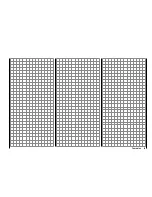
83
Detail program description - Model type
controlled instead by way of the "
Dual
mixer
" menu, page 194. In this case
however, the tail type entry specifi ed here
must
be "normal".
"Delta/fl ":
Aileron and elevator control is operated
by one or two servos per wing half.
However, elevator trimming is also
affected by selecting the "QR 2WK"
option – see below – but only on servos 2
& 3.
"8": This option is intended for models
with two elevator servos. The servo
connected to output 8 will operate in
parallel with servo 3 to actuate elevators.
Elevator trimming affects both servos.
Notice about the "8" option:
One control, which assigns input 8 by
way of the
"Control adjust"
menu, is
then disconnected from servo "8" by
software for reasons of safety i. e. it is
made ineffective.
Aileron/Flaps
After selecting the "Aile/fl aps" line with the
arrow
keys of the left or right touch pad, the corresponding
entry fi eld will be framed.
+100%
SEL
Tail type
Motor at C1
Nor mal
None
Aile/flaps
1AIL
M O D E L T Y P E
Brake Off
In 1
Press briefl y on the center
SET
button in the right touch
pad. The current setting will be displayed in inverse
Brake offset
This function not only has potential for gliders and
electric models but also for models with combustion
motors and landing fl aps.
The mixers described in the "Brake settings" line of
the "
Wing mixers
" menu can be operated by the C1
control stick ("input 1") or another transmitter operating
element which has been assigned to input 7, 8 or 9 in
the "
Control adjust
" menu. In this latter case, retain
the "GL" default setting for the "Type" column in the
"
Control adjust
" menu so the selected control can
operate independent of fl ight phase.
In the majority of cases the default setting for "input 1"
will remain as it is and the brake will be operated by way
of the non-neutralizing C1 joystick.
However, use of input 7, 8 or 9 makes it possible to
operate the brake in an alternative manner, even by way
of a supplementary control, if the C1 stick is to be used
for something else.
The neutral point (offset) can be set to any desired
position. This is done by placing the control for input 1,
7, 8 o 9 into the position at which the landing fl aps are to
be in their neutral position then fi xing this "Offset" point
there with
STO
.
+90%
SEL
STO
Tail type
Motor at C1
Nor mal
None
Aile/flaps
1AIL
M O D E L T Y P E
Brake Off
In 1
If the offset point is not set at the far end of control
element travel, the remainder of travel to the end point
will be "free travel", i. e. this "free travel" will no longer
video. Now use the arrow keys of the right touch pad to
select the number of wing servos to be programmed for
the model.
Available
Control channel used
1QR
2
1QR 1WK
2 | 6
2QR
2 + 5
2QR 1WK
2 + 5 | 6
2QR 2WK
2 + 5 | 6 + 7
2QR 4WK
2 + 5 | 6 + 7 / 9 + 10
4QR 2WK
2 + 5 / 11 + 12 | 6 + 7
4QR 4WK
2 + 5 / 11 + 12 | 6 + 7 / 9 + 10
Depending on the option selected here, the given mixers
needed and their settings will be activated in the
"Wing
mixers",
menu beginning page 146.
Tips:
Settings for all wing fl ap pairs (QR and QR2, WK and
•
WK2) can be trimmed on a fl ight-phase basis in both
the "
Phase trim
" menu and in the "
Wing mixers
"
menu, page 146.
The functionality of all wing fl ap pairs (QR and QR2,
•
WK and WK2) can also be operated by way of the
"Throttle/brake-fl ap stick" if this stick has not been
assigned to other use, e. g. for certain brake settings,
see "
Wing mixers
" menu, page 146. To confi gure
this it is only necessary to assign "Control 1" to input
6 in the "
Control adjust
" menu, page 96. (If you
would rather operate fl aps with switches, one of the
transmitter's two or three position switches are good
for this purpose.)
Summary of Contents for mx-20 Hott
Page 41: ...41 Your notes...
Page 49: ...49 Your notes...
Page 55: ...55 Your notes...
Page 81: ...81 Your notes...
Page 85: ...85 Your notes...
Page 89: ...89 Your notes...
Page 99: ...99 Detail program description Control adjust...
Page 127: ...127 Detail program description Control adjust...
Page 131: ...131 Detail program description Control adjust...
Page 163: ...163 Detail program description Control adjust...
Page 191: ...191 Detail program description Control adjust...
Page 207: ...207 Detail program description Control adjust...
Page 228: ...228 Detail program description Control adjust...
Page 229: ...229 Detail program description Control adjust...
Page 251: ...251 Detail program description Control adjust...
















































